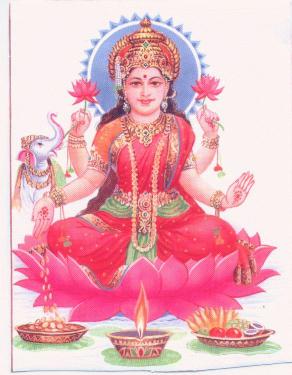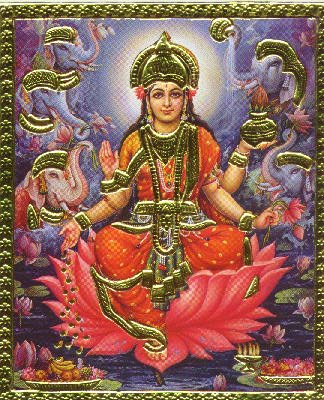|
|
|






|
 |
|
 |
 |
 |
 |
Goddess LakshmiLakshmi is the Goddess
of wealth and prosperity, both material and spiritual. The word ''Lakshmi''
is derived from the Sanskrit word Laksme, meaning "goal." Lakshmi, therefore,
represents the goal of life, which includes worldly as well as spiritual
prosperity. In Hindu mythology, Goddess Lakshmi, also called Shri, is the
divine spouse of Lord Vishnu and provides Him with wealth for the maintenance
and preservation of the creation.
In Her images and pictures, Lakshmi is depicted
in a female form with four arms and four hands. She wears red clothes with
a golden lining and is standing on a lotus. She has golden coins and lotuses
in her hands. Two elephants (some pictures show four) are shown next to
the Goddess. This symbolism conveys the following spiritual theme:
-
The four arms represent the four directions in space
and thus symbolize omnipresence and omnipotence of the Goddess. The red
color symbolizes activity. The golden lining (embroidery) on Her red dress
denotes prosperity. The idea conveyed here is that the Goddess is always
busy distributing wealth and prosperity to the devotees. The lotus seat,
which Lakshmi is standing upon, signifies that while living in this world,
one should enjoy its wealth, but not become obsessed with it. Such a living
is analogous to a lotus that grows in water but is not wetted by water.
-
The four hands represent the four ends of human life:
dharma (righteousness), kama (genuine desires), artha (wealth), and moksha
(liberation from birth and death). The front hands represent the activity
in the physical world and the back hands indicate the spiritual activities
that lead to spiritual perfection.
-
Since the right side of the body symbolizes activity,
a lotus in the back right hand conveys the idea that one must perform all
duties in the world in accordance with dharma. This leads to moksha (liberation),
which is symbolized by a lotus in the back left hand of Lakshmi. The golden
coins falling on the ground from the front left hand of Lakshmi illustrate
that She provides wealth and prosperity to Her devotees. Her front right
hand is shown bestowing blessings upon the devotees.
-
The two elephants standing next to the Goddess symbolize
the name and fame associated with worldly wealth. The idea conveyed here
is that a true devotee should not earn wealth merely to acquire name and
fame or only to satisfy his own material desires, but should share it with
others in order to bring happiness to others in addition to himself.
-
Some pictures show four elephants spraying water
from golden vessels onto Goddess Lakshmi. The four elephants represent
the four ends of human life as discussed above. The spraying of water denotes
activity. The golden vessels denote wisdom and purity. The four elephants
spraying water from the golden vessels on the Goddess illustrate the theme
that continuous self-effort, in accordance with one's dharma and govemed
by wisdom and purity, leads to both material and spiritual prosperity.
Goddess Lakshmi is regularly worshipped in home shrines
and temples by Her devotees. A special worship is offered to Her annually
on the auspicious day of Diwali, with religious rituals and colorful ceremonies
specifically devoted to Her.
- Bansi Pandit
Pictures



Lakshmi Bhagwati
| |
 |
 |
 |
 |
|
|
|
|
|
|
